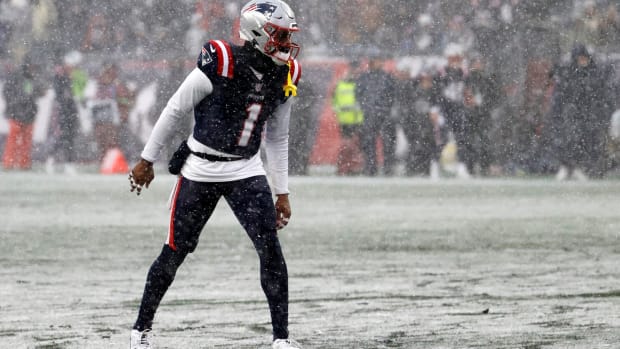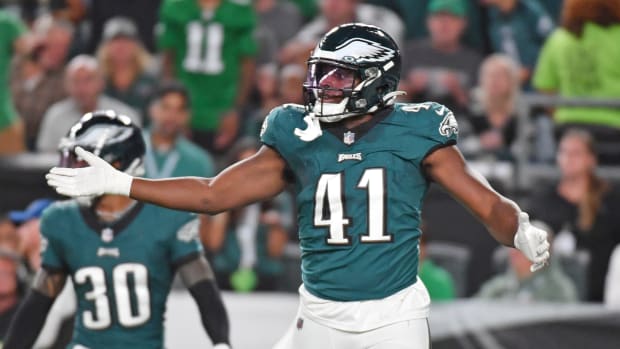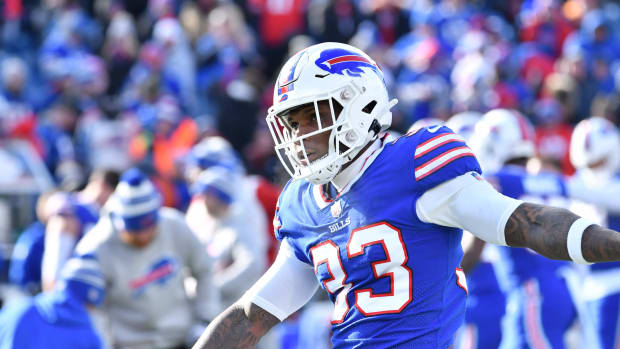SI 64: Nos. 44–40: Jaelen Strong, Jalen Collins, Ameer Abdullah, more
With the 2015 NFL draft fast approaching, it’s time for all 32 NFL teams to start getting their draft boards in order and ranking players based on their own preferences. At SI, it’s time for us to do that as well. To that end, Doug Farrar and Chris Burke have assembled their own definitive Big Board, consisting of the players they feel deserve to be selected in the first two rounds.
• The SI 64 (so far): Counting down top prospects in 2015 NFL draft
You can see the already-published writeups, featuring Jay Ajayi, Nelson Agholor and the other players who joined them at Nos. 49–45 on the list, here. In our new installment, there are a number of underrated players—including a potentially dominant pass rusher, a receiver who's going to be something else with a better quarterback throwing to him, a speed receiver who could break out in the NFL, a cornerback with little experience but tons of upside, and a running back with nearly every attribute needed for success.
44. Owamagbe Odighizuwa, DE, UCLA
Bio: Odighizuwa started six games as a true freshman in 2011, and he played in every one of UCLA’s contests from '11–12 and in '14. He lost the entire 2013 season, though, because of separate surgeries on each of his hips. Back in the lineup for his redshirt senior year, Odighizuwa recorded 61 tackles, 6.0 sacks and a team-leading 11.5 tackles for loss—four of which came in a single outing against Utah. In the 2012 and ‘14 seasons combined, he posted 17.5 tackles for loss and 9.5 sacks.
Strengths: Should be able to step in and help against the run almost immediately. Plays with the power necessary to hold the edge, no surprise to anyone who has seen him in person—he’s built like he has been in an NFL weightlifting program for years. Good leverage when met by a blocker, driving forward from his legs. Aggressive use of his hands, which provides a necessary complement to his lower-body power. Battles off blockers to make tackles and capable of stringing run plays to the sideline. Stunts with enough authority to be a handful. Tested extremely well at the combine (4.62 40-yard dash, 39-inch vertical, 127-inch broad jump). Ought to be no questions from scouts about his effort level, as he plays 60 minutes at top speed. Projects as either a 4–3 DE or 3–4 OLB; that versatility will help him.
Weaknesses: Even though he said that his combine medical tests went off without a hitch, Odighizuwa’s 2013 injury woes will drive him down some draft boards. Does not possess tremendous sideline-to-sideline speed as it is. If the hip issues resurface and/or cost him any of his leg drive, it will be tough for him to make a long-lasting impact. Career sack numbers oversell his actual abilities as a pass-rusher. Initial burst, rush design or broken plays will get him some shots, but he does not generate a whole lot on his own off just his repertoire. Sticking point on a 3-4 linebacker move could be in coverage—little to no evidence thus far that he can handle those assignments in the NFL, despite his footwork.
• FARRAR: Marcus Peters doing all of the right things ahead of draft
Conclusion: The notions of a two-down linebacker or two-down defensive tackle are familiar ones in casual NFL parlance. A two-down DE is not quite as common, but there are some players cut from that cloth, and Odighizuwa is, at the bare minimum, in that class. Given his 12.5 career sacks while at UCLA and developing game, though, there should be some hope that he can stay on the field for all three downs. He will provide potential immediate impact vs. the run as a rookie. He could be an All-Pro-caliber, all-around defensive end a couple of years down the road.
Pro Comparison:Everson Griffen, Vikings (Round 4, 2011)
—CB
[youtube:https://youtu.be/mQtd3Z4UZOM]
43. Devin Smith, WR, Ohio State
Bio: As a senior on Ohio State’s national championship-winning team, Smith posted 931 yards receiving and 12 touchdowns … on just 33 catches. The math on that works out to a mind-blowing 28.2 yards per catch and a touchdown every 2.75 times he hauled in a pass. For his career Smith averaged 20.1 yards on 121 catches, finishing with 2,501 total yards receiving and scoring 30 times. He was an Honorable Mention All-Big Ten member in 2014. Smith returned kicks and punts during his first two Ohio State seasons.
Strengths: Will be tabbed by some as a “speed” receiver, but it’s actually what he does once he gets downfield that separates him in this class. Simply incredible when the ball is in the air, tracking it about as well as you’ll see from a college receiver. Able to get win the position battles with cornerbacks and safeties, too, so those deep passes find their home. Adjusts to underthrown passes when necessary. Also goes up and finds the football in the air, leaping and high-pointing it. Explodes in and out of breaks at times, perhaps hinting that he could become a dangerous intermediate weapon if he refines his approach. Has a chance to be one of those receivers that drives cornerbacks (and opposing fans) nuts wit the number of penalties he draws. Remember, NCAA rules permit defenders to keep their hands on receivers until the ball is in the air. Without the benefit of that cushion, Smith more easily will find his way deep and he has the know-how to create contact. Never missed a game in college.
Weaknesses: Everything about his game on plays closer to the line of scrimmage needs more consistency. Route-running could become a real plus but it’s middle-of-the-road right now—rounds some off, doesn’t always hit the gas when headed inside, etc. Will have to get better at reading defenses to become more than just a deep threat; it won’t always work to just go long. Is less of a sure thing catching the football on short and intermediate routes than when he has to go get it downfield, but might just be a timing thing and letting the ball get too close to his body when he’s working back toward the line. To be a top-two receiver on a team, he’ll have to show more interest in blocking. Otherwise, he will be relegated mostly to three-receiver sets and passing downs. Decent size but nothing more. Physical cornerbacks will succeed at frustrating him on occasion.
• VRENTAS: Dante Fowler talking big ahead of NFL draft
Conclusion: There might not be a player in this draft class as dominant in one specific area as Smith is at winning on the deep ball. NFL defenses will have to account for him whenever he sets foot on the field. Whether or not he can package that skill with a more complete game remains to be seen. Improvement in his routes and a better awareness for the coverage he is facing—both very teachable areas—would skyrocket Smith's upside. For a team with a very specific need for a home-run threat, he's still worth Round 1 consideration now.
Pro Comparison:Torrey Smith, 49ers (Round 2, Ravens, 2011)
—CB
[youtube:https://youtu.be/8ApMQsx0m8M]
42. Ameer Abdullah, RB, Nebraska
Bio: In 2014, Abdullah led the Big Ten in rushing with 1,611 yards and 19 touchdowns on 264 carries, and he was highly productive throughout his career with the Cornhuskers. Possibly the best senior back in this class leaves the NCAA with 4,588 yards and 73 touchdowns on 813 carries, with 690 receiving yards, 1,592 kick return yards and 316 punt return yards mixed in. Size and power issues will probably prevent Abdullah from becoming a three-down back in the NFL, but that doesn't diminish his true value. His pro team will just have to know what he does best, and adapt accordingly. There's a lot to like.
Strengths: Outstanding speed, acceleration and body lean—transitions smoothly to the second and third levels. Runs low and forward to pick up extra yards between the tackles. Patient when waiting for blocks to open gaps, and moves to the edge quickly and efficiently. Team leader who works very hard and has an obvious desire to improve. Runs very decisively to and through the gap, and has the vision to take advantage of quick-opening opportunities. Not blessed with great escapability, but has good lateral agility and fights to create openings as he runs downfield.
Weaknesses: As expected from a player his size (5'9", 205 pounds), Abdullah struggles in power situations. Not a sustaining back when dealing with bigger defenders, and has issues keeping his body straight when blocking. Won't be able to put on much more weight. Needs to develop a wider array of routes, and more accuracy when running them. Fumbled 13 times at Nebraska. Best suited to a zone scheme at the next level—could struggle with power/counter/trap schemes that require more power and patience.
• Audibles Podcast: Going behind the scenes of this year's SI 64
Conclusion: Abdullah doesn't project as an every-down back in the NFL because of his size and attendant power issues, but he could be a very valuable cog in a multi-faceted running game. In a system that defines rushing openings to the edge and relies on big plays in space, he'd be a real asset. Add in his value as a returner, and second-round consideration isn't out of the question.
Pro Comparison:Andre Ellington, Cardinals (Round 6, 2013)
—DF
[pagebreak]
41. Jaelen Strong, WR, Arizona State
Bio: In two season with the Sun Devils, Strong totaled 157 catches for 2,287 yards and 17 touchdowns, becoming one of the Pac-12's most productive receivers from the start of his time on the field despite a tenuous-at-best quarterback situation. Unable to qualify for the one FBS offer he received out of high school (Eastern Michigan), Strong spent 2011 as a highly productive JUCO receiver at Pierce College in Los Angeles, and redshirted for ASU in '12. Strong doesn't explode off the tape, but all the elements of a complete NFL receiver seem to be in place, or on the way.
Strengths: Primary attribute is that he'll most likely become an entirely new receiver with a consistent and accurate NFL quarterback—his passers at Arizona State were inconsistent at best. Has learned to expand his catch radius as a result. Well-built player (6'2", 217 pounds) with the upper-body strength to deal with press coverage and win physical battles downfield. Can break free of tight coverage to snatch the ball out of the air with excellent timing. Knows how to use his hands to get separation. Understands how to stay open and extend the play when his quarterback moves out of the pocket. Willing and above-average blocker. Fearless when extending his body to make a catch and has no trouble taking hits in traffic. Credible receiver outside and in the slot.
Weaknesses: Not a burner off the snap at all, though he does have another gear as he gets going—tends to lope when he runs, and he's not all that sudden in his breaks. Route exactness is a work in progress, as he rounds deeper routes off and doesn't run quick-breaking routes consistently. Needs to track the deep ball better and avoid letting the ball sink into his body—must stab the ball with his hands more often.
• Audibles Podcast: Going behind the scenes of this year's SI 64
Conclusion: While Amari Cooper and Kevin White will the lion's share of accolades among receivers in this draft class, there's a growing feeling that Strong may be among the most productive NFL targets in this group—especially when he's put in an offense with a functional and reliable quarterback. He's an aggressive, consistent player with speed that will surprise, and an upside hidden by the limitations of others. The best is yet to come with Jaelen Strong.
Pro Comparison: Muhsin Muhammad, Panthers (Round 2, 1996)
—DF
[youtube:https://youtu.be/4I5tFGvN-2w]
40. Jalen Collins, CB, LSU
Bio: Though Michigan State's Trae Waynes is regarded as the most pro-ready cornerback in this draft class, Collins may eventually overtake him as the best NFL pass defender. Though only 10 starts in his LSU career (LSU constantly rotates its secondary because there's so much talent), Collins amassed 90 tackles, three tackles for loss, three interceptions and 19 passes defensed. He checks all the height-weight-speed boxes, most of his deficits are coachable, and he does fit the prototype of a number-one NFL cornerback in some very exciting ways.
Strengths: Fiery competitor with the ideal frame (6'1", 203 pounds) and aggressiveness for the modern NFL. Has an excellent feel for what's going on in front of him—will break off coverage to help underneath and isn't generally fooled by crossing routes. Outstanding press corner who will re-direct receivers to the boundary and has the speed to keep up downfield. Passionate tackler in run support. Good blitzer who understands angles. Short-area quickness to jump routes and dive in to make plays. Times jump-balls very well and always has an excellent chance of winning vertical battles. Ran a 4.48 40 and posted the top three-cone time at the combine despite a foot injury that subsequently required surgery.
Weaknesses: Gets a little lost at times in off coverage and press-bail concepts—anything where he has to time his backpedal to the rhythm of the play. Can be too stiff and upright in his steps in those situations. Needs to improve diagnosis and pattern reading on quick-breaking routes. Limited experience as a starter could have more savvy NFL receivers giving him fits at times. May need to start his pro career in the slot or as a hybrid rotational player.
• FARRAR: Ranking top offensive tackles in 2015 NFL draft
Conclusion: While Collins' lack of experience will undoubtedly show when he's on an NFL roster, he's going to be very appealing to pro teams, because he has the frame and aggressiveness required against modern passing games. Over time, he has all the attributes to be one of the better press cornerbacks in the league.
Pro Comparison:Prince Amukamara, Giants (Round 1, 2011)
—DF
[youtube:https://youtu.be/3IBdmMYmVCQ]




































